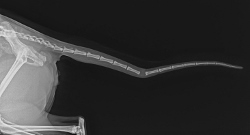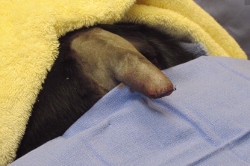
Jimi is an adventurous Seattle cat, who loves to spend his days exploring the outdoors. One evening, Jimi was found hiding in his house after an eventful day outside. When Jimi came out of his hiding place, his family noticed that his tail was dangling. They also noticed that he was cowering and acting painful. Jimi was taken to an emergency veterinary hospital late that same evening for evaluation of his tail and medical care.
 During his exam, the attending veterinarian noticed that there was swelling at the middle of Jimi’s tail and that it was very painful to the touch. Jimi was unable to move the end of his tail and seemed to have decreased feeling or sensation in the end of his tail. An x-ray revealed that there was a complete break in the tail just where the swelling was present.
During his exam, the attending veterinarian noticed that there was swelling at the middle of Jimi’s tail and that it was very painful to the touch. Jimi was unable to move the end of his tail and seemed to have decreased feeling or sensation in the end of his tail. An x-ray revealed that there was a complete break in the tail just where the swelling was present.
Tail breaks in cats can happen for a number of reasons, usually from either a “tail pull” incident or from a traumatic incident (such as a fight with a cat or dog or an automobile accident). Tail pulls can occur from a tail being caught in a closing door or from a child pulling on the tail while the cat tries to run away. *It is important to teach children NEVER to pull on a cat’s tail. These injuries frequently cause the bones in the tail to pull apart, stretching the nerves and damaging the ligaments that hold the tail together. Often there are not external injuries present, such as cuts and scrapes. Instead, one might only notice that the tail is dangling or that the cat seems painful. In Jimi’s case, it is unknown how his tail break occurred, but it is thought that he may have gotten it caught in a gate outside.
 With a complete break, such as Jimi’s, often the nerves and blood vessels are damaged to an extent that they can cause the lower part of the tail to lose blood supply, feeling, and movement. The tail can sustain further damage from being dragged on the ground and, if left long enough, it can start to die due to its loss of blood supply. In some cases, if the tail is broken close to the body, the nerves near the hip can be damaged. This can result in lack of bladder control, fecal incontinence, and lack of control of the back legs. Luckily, Jimi’s tail break was farther down his tail and he did not damage the nerves in that area.
With a complete break, such as Jimi’s, often the nerves and blood vessels are damaged to an extent that they can cause the lower part of the tail to lose blood supply, feeling, and movement. The tail can sustain further damage from being dragged on the ground and, if left long enough, it can start to die due to its loss of blood supply. In some cases, if the tail is broken close to the body, the nerves near the hip can be damaged. This can result in lack of bladder control, fecal incontinence, and lack of control of the back legs. Luckily, Jimi’s tail break was farther down his tail and he did not damage the nerves in that area.
 Due to the complete break in Jimi’s tail, surgical amputation was recommended to prevent further damage to his tail. Jimi was prescribed pain medications and his surgery was scheduled at Hawthorne Hills Veterinary Hospital in Seattle. Dr. Shawna Wedde amputated Jimi’s tail just above the location of the break, removing over half of his tail. The surgery was successful and Jimi now struts around outside happily showing off his bobbed tail.
Due to the complete break in Jimi’s tail, surgical amputation was recommended to prevent further damage to his tail. Jimi was prescribed pain medications and his surgery was scheduled at Hawthorne Hills Veterinary Hospital in Seattle. Dr. Shawna Wedde amputated Jimi’s tail just above the location of the break, removing over half of his tail. The surgery was successful and Jimi now struts around outside happily showing off his bobbed tail.
For more information on cats with broken tails, please read the following articles:
http://www.veterinarypartner.com/Content.plx?P=A&S=0&C=0&A=1322
http://www.gopetplan.com/blogpost/petplan-pet-insurance-broken-tails-in-cats

